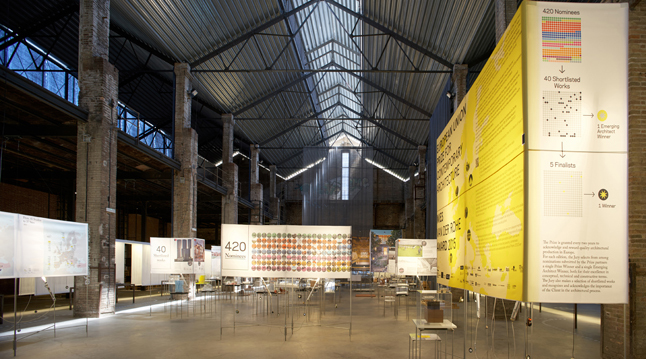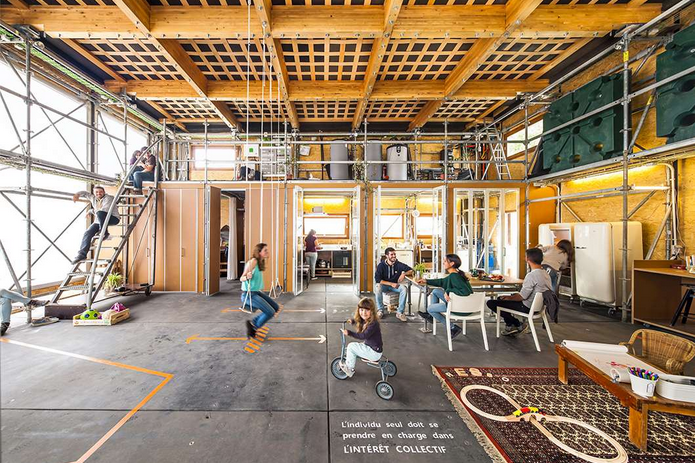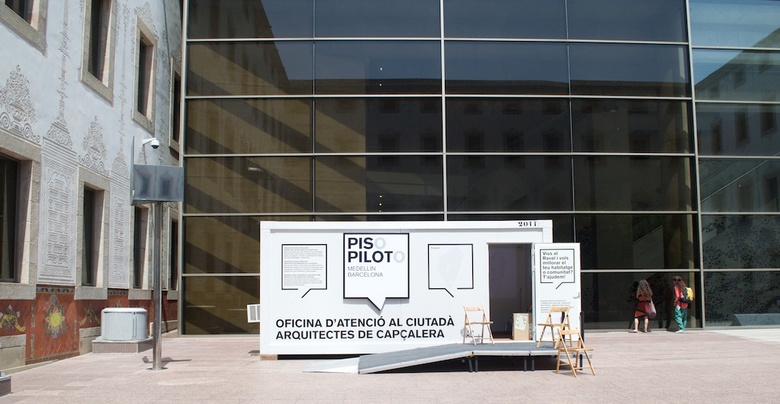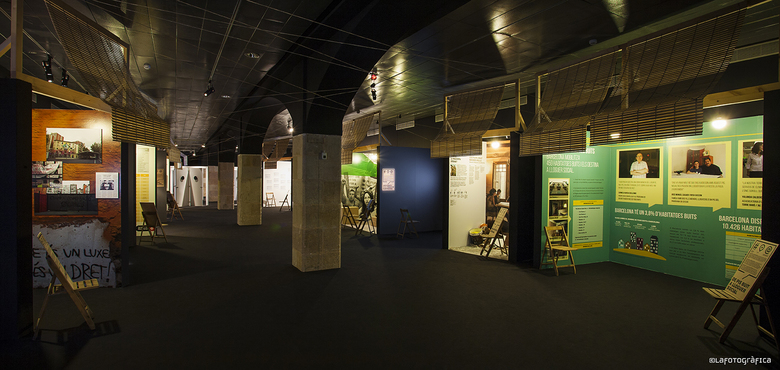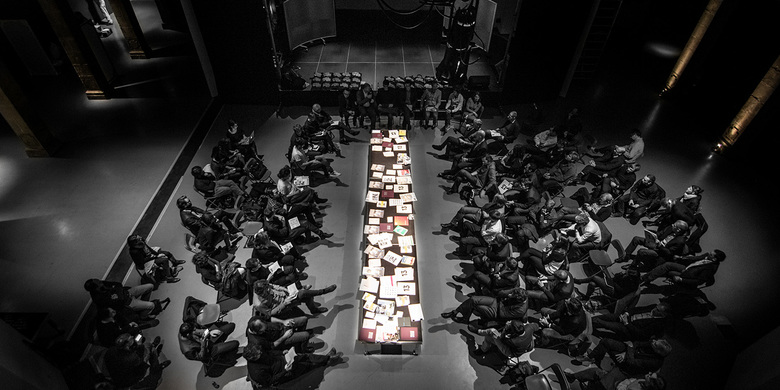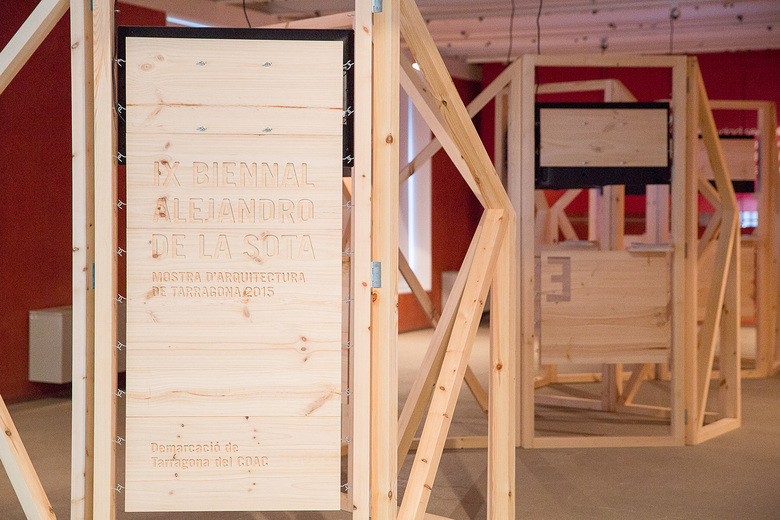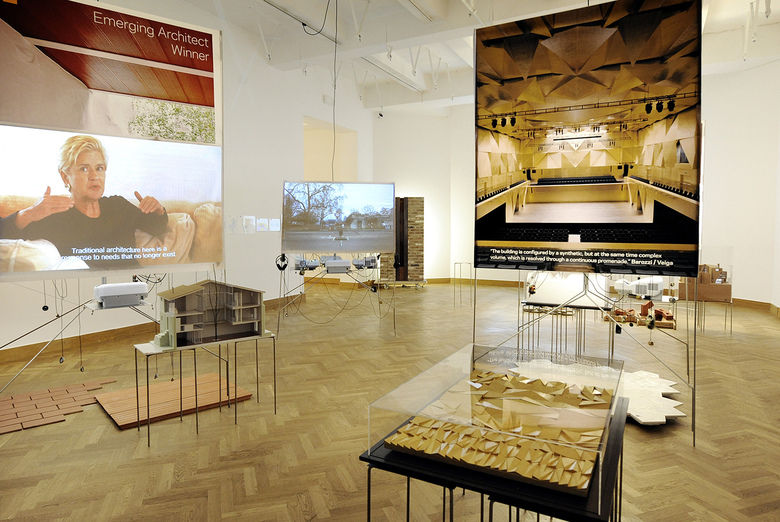3x3: Snapshots of Catalonian Architectural Production
Xavier Bustos
28. September 2015
EU Mies Award Traveling Exhibition at MUHBA Oliva Artés, Barcelona (Photo: Pepo Segura)
To parse just what it is that creates the distinctive architecture of Barcelona and the Catalan region, architect and Cities Connection Project co-director Xavier Bustos presents three snapshots in three categories of architectural production: education, cultural initiatives, and awards.
Recognizing the characteristic traits that would give us an approximate idea of what constitutes Catalan architecture is no easy task. The first thing we need to ask ourselves is if there are indeed shared qualities that can be linked to a specific method of creating architecture in a particular territory such as Catalonia. Perhaps it would be even more interesting to take a snapshot of Catalan architecture from different perspectives, both locally and globally. This would present us with diverse and complex visions and points of view which might – or might not – lead to an answer.
In any case, it must be borne in mind that architecture is a complex practice that is initiated in the training period in architecture schools, and which, once the architect is professional, is closely linked to the place where he or she works, while also highly influenced by external factors. In short, we cannot have an overview of what Catalan architecture is today without taking into account this complexity.
Among the evidence for this complexity in Catalonia is the current interrelationship between the teaching of the subject (architectural schools with different studies programs and diverse teaching staffs), several interesting cultural initiatives promoting the values of quality architecture (public, private or mixed) and a large number of established prizes and recognition awards which make the general public more aware of good architecture (whether at a local or an international level).
So, it is with this complexity in mind, that I provide a snapshot of the current situation of Catalan architecture from the different perspectives that I will outline and try to develop below, in order to give the reader a general idea of the field.
Education
Turning to the educational panorama, we see that in Catalonia, with a population of approximately seven million, there are eight public and private architectural schools: ETSAB, ETSALS, ESARQ and IAAC in Barcelona, ETSAV in Sant Cugat, ETSALS in Tarragona, URV in Reus and UDG in Girona. While doubtless excessive given existing demand, this wide range of options presents the student with a diverse panorama from which very interesting transversal initiatives emerge. I would like to focus on three initiatives that reinforce the healthy future perspectives I see for professional architects in the country.
RESSÓ (ETSAV) project (Photo: Andrés Flajszer)
The first is an international competition: Solar Decathlon Europe. One submission to this event involved more than 40 students from a Catalan architecture school (ETSAV) working together on a proposal entitled Project Ressò; it was presented at the latest edition in Versailles, France. The aim of the competition is to produce “sustainable” houses that are highly energy-efficient and cost-effective and use very limited financial resources. Students compete (and share at the same time) with other educational establishments from around the world. Year after year, the results have proved to be spectacular.
Arquitectes de Capçalera (ETSAB)
The second initiative is known as Arquitectes de Capçalera (Social Architects) which proposes a direct relationship between a group of enthusiastic students from the ETSAB with the actual inhabitants of their city, covering all the difficulties of the environment in which the latter live and for which they might be able to propose different solutions. A public service office staffed by "future architects" promotes a professional relationship between students of architecture and the general public who need their help.
CTPA project (Photo: Lafotografica)
The third scheme is a transversal experience known as the Confederació de Tallers de Projectes d’Arquitectura (CTPA, Confederation of Architectural Project Workshops) set up between the architectural schools of Barcelona and Tarragona (ETSAB, ETSAV, ETSALS BCN-TGN, ESARQ and IAAC). Around 300 students have worked together on projects throughout their courses focusing on the urgent accommodation problems in the districts of Ciutat Meridiana and Torre Baró. These have led to a compendium of mini publications outlining different proposals made by students, along with the publishing of a glossary which gathers together the most important concepts essential in any dialogue about social housing.
Cultural Initiatives
If we turn to cultural initiatives, a snapshot of what is happening now can be seen in three collective exhibitions about Catalan architects, that have contrasting curatorial conceptions and antagonistic visions, but which are, consequently, complementary.
Grafting Architecture exhibition at 2014 Venice Biennale (Photo: John Hill/World-Architects)
The first would be the Catalan architecture pavilion at the Venice Architectural Biennale (Eventi Collateralli) which was presented under the heading Grafting Architecture. With the capacity to create dialogue with pre-existing conditions as a guiding thread, a wide selection of architectural projects from different generations were included, each using as a reference point the work of Josep Maria Jujol and the refurbishment of the Casa Bofarull, the origin of this curatorial proposal.
Piso Piloto Exhibition at CCCB (Photo: Lafotografica)
The second, the Piso Piloto exhibition (CCCB) presented around 40 contemporary projects and initiatives from different areas of intervention involving students, lecturers, professionals, institutions, collectives and private citizens. It attempted to offer solutions for the accommodation problems our society is experiencing and, simultaneously, reformulate new parameters for the architectural profession.
Cities Connection Project meeting at Santa Monica (Photo: Adrián Pedrazas)
The third, the Cities Connection Project, is an initiative that, through thematic exhibitions, connects Barcelona architects with colleagues from other cities. In its third edition, hosted at COAC (Col·legi d'Arquitectes de Catalunya / Association of Architects of Catalonia) will put on view twenty social housing projects drawn up by young Catalan architects and twenty cooperative housing projects conceived by young architects from Zürich. There will be a double exhibition in both cities along with debates and professional and cultural exchanges.
Awards
Finally, we turn to analyze another perspective, or group of perspectives, those offered by architectural awards, which are well established in our culture. These range from prizes covering local or regional areas (Alejandro de la Sota Biennial in Tarragona, Mostra de les Terres de l’Ebre, Mostra de les Terres de Lleida, Mostra d’arquitectura del Maresme, Premis de les Comarques de Girona, etc.) to awards from across Spain in which the selection of Catalan projects is contextualized (the FAD Awards, the Spanish Architecture Biennial, etc.), or even to those at an international level, where projects are presented across the whole of Europe (the EU Mies van der Rohe Prize, the European Landscape Biennial, etc.). This leads me to focus on three significant examples.
Biennal Alejandro de la Sota (Photo courtesy of Arxiu Demarcació deTarragona Col·legi d'Arquitectes de Catalunya)
At a local level, we can concentrate on the Alejandro de la Sota Biennial in Tarragona, which displays architecture constructed across the province of Tarragona in the last two years and offers little-known architectural studios the opportunity to demonstrate their high quality work. This is consolidated in a catalogue and exhibition at the COAC head offices. Together with the rest of the local awards previously mentioned, these represent a generous panorama of architecture from across the whole of Catalonia.
FAD Awards
Turning to Spain, there are the FAD Awards for Architecture and Interior Design, inaugurated in Barcelona in 1958. Over the years it has become a reference point for the entire Iberian Peninsular, given the always large number of projects presented and independent juries that select the finalists. It represents a good example of the best architecture completed during the previous year. It is divided into five categories (Architecture, Interior Design, Landscape, Ephemeral Interventions, and an International section). There is also a sixth category covering Opinion and Criticism which awards the best writing of the year on architecture.
EUMiesAward 2015 Traveling Exhibition at BOZAR (Photo: Fred Guerdin)
On the international scale obviously the EU Mies van der Rohe Award comes to mind. This is also managed from Barcelona, where a multitude of projects from across Europe (all finished in the previous two years) are presented. The biennial award has generated a debate about the hypothetical recognizability of European architecture compared with that of other continents, which brings us back to the question asked at the beginning of this article. Curiously enough, the latest edition of the award was won by two architectural teams with studios in Barcelona, both in the main category and the emerging architect grouping; the prizes were for projects constructed, respectively, in Szczecin (Poland) and Cilleros (Spain).
Conclusion
So, reviewing all of these different visions of what might be called Catalan Architecture, from public promotions to private initiatives, from large to small scale, from architectural schools or from different teaching staffs, from a monographic exhibition to joint presentations of regional architecture, we can see that architecture of place can have many different readings. In the case of Catalonia, I think the richest interpretation represents a sum of all of these visions, such as complex realities, connected sectors, different disciplines, a range of generations, loose relationships, and diverse economic and cultural contexts. These are more difficult to evaluate at first glance and demand repeated readings.
From these readings and rereadings I draw the conclusion that, despite the economic crisis which has devastated the architectural sector (and saw production levels plummet to historical minimums) in Catalonia there continues to be a very high level of professional quality and a good foundation of young architects who, despite coming of age in a very complicated context, have begun to leave their mark.
Xavier Bustos Serrat is an architect, co-director of "Cities Connection Project" and Professor of "Projectes III" at ETSALS Tarragona.
Photographers: Andrés Flajszer, Lafotografica, Pepo Segura, Adrián Pedrazas, Fred Guerdin.
Related articles
-
Launch of Catalan-Architects
on 9/28/15
-
Greening Plaza de les Glories
on 9/25/15
-
The Architecture of Barcelona's Markets
on 9/23/15
